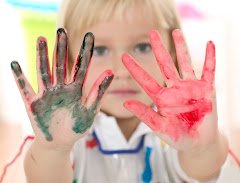As is often the case, I have more questions than answers on the topic of social emotional needs of children with an exceptionality. I could learn and write about this topic for the rest of the year and still only glaze the surface. I want to make the effort to bring it up because it is so important. It is important to the child with the need just as it is to the children who are interacting ( or as is often the case, not interacting) with the child. It fits in with the topic of diversity because part of diversity is helping children learn about and accept others. If children can be accepting of children with an exceptionality, it will be easy to transfer those skills to people who speak another language, look different, or have different customs.
I used to think that preschoolers were pretty accepting and they often are, but not always. As time goes on they can loose interest in the child whose speech is not understandable, or decide not to play with the child whose hyperactivity disrupts their play. I've seen children, who otherwise have exceptional social skills refuse to hold the hand of a child who has a slight deformity. Is it because of the deformity, because the child's lack of speech skills or the behavior of the child in class? Probably a little of each. And the action of other children affects the way the child with the special need feels about him or herself.
Social emotional assistance should always be considered when we are determining the needs of a young child with a a special need. It is important to find ways for the child with articulation difficulties to communicate with others. So often teachers are told to teach children to use their words when there is a conflict, but when a child is physically unable to do this, the advise often sounds something like this, "It will get better when the child's speech catches up." That cannot be an acceptable answer. We've got to find a way to make an effort to teach the group sign language, use picture cards or whatever is necessary to help that child be a part of the group. Leann taught us at the Governor's Institute to use social stories and I think that is a valuable start. There are a number of websites which can give you more information on using social stories with children but I think the following is one of the best: http://www.vanderbilt.edu/csefel/practicalstrategies.html
Marisa Macy, assistant professor of special education, at Penn State suggests teachers use the strategy of embedding social-emotional instruction throughout the day. If you would like to learn more about her work, you can go to: http://www.ed.psu.edu/educ/news/news-items-folder/embedding
Here are a few books which may help your class be more accepting of differences in others:
Zoom! by Robert Munsch
Susan Laughs Jeanne Willis
Leo the Late Bloomer Robert Kraus
Friends at School by Rochelle Bunnett
We Can Do It, by Laura Dwight
My Friend Isabelle (Hardcover) by Eliza Woloson
As I said when I started, I have a lot more questions than answers. Please share your thoughts and help me and others help all the children in our lives increase their social emotional skills.

Subscribe to:
Post Comments (Atom)


No comments:
Post a Comment